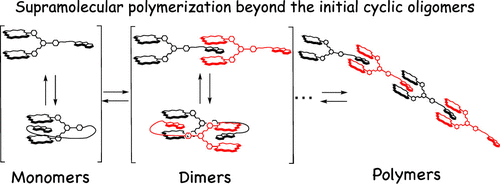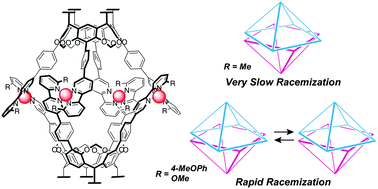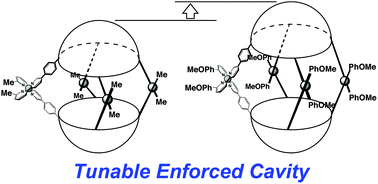Publication Lists
・Original Papers(2025 / 2024 / 2023 / 2022 / 2021 / 2020 / 2019 / 2018 / 2017 / 2016 / 2015 / 2014 / 2013 / 2012 / 2011 / 2010 / 2009 / 2008 / 2007 / 2006 / 2005 / 2004 / 2003 / 2002)
・Review&Books
2019




●A Protocol for Separation of Nanographenes

Top-down methods are convenient preparative methods for nanographenes, although the products consist of graphene fragments with a broad size distribution. We show that a combination of dialysis membranes (50, 25, 15, 8, and 2 kD) can conveniently separate nanographenes into five size distributions. The separated nanographenes can be employed as starting materials for carbon-based functional materials.
Matsumoto, Ikuya; Sekiya, Ryo;Haino, Takeharu, RSC Adv ., 2019, 9, 33843-33846. (Hot Article)
●Conformational Characteristics of Feet-to-Feet-Connected Biscavitands

X-ray crystallography of an acetoxy-protected bisresorcinarene and biscavitands possessing phosphonate and dialkylsilyl bridges revealed that the bisresorcinarene and the biscavitands adopt helical forms in the solid state. Helical conformations were also found in solution. The helix–helix interconversions of the biscavitands occurred with high activation barriers of more than 50 kJ mol–1. The activation parameters of the helix–helix interconversions were determined using exchange spectroscopy (EXSY). The positive activation enthalpies and the negative activation entropies suggest that the transition states of the helix–helix interconversion process are most likely more strained and symmetric than the ground states. The compensatory enthalpy–entropy correlation is found in the series of activation parameters, giving rise to a compensation temperature of 254 K.
Shimoyama, Daisuke; Haino,Takeharu, J. Org. Chem ., 2019 , 84 , 13483-13489(Front Cover)
●Intrinsic Emission from Nanographenes

Top‐down approaches have been widely used as convenient methods for the production of nanographenes. To understand the photoemission properties of nanographenes, their separation and the optical properties of the individual fractions is important. By using a combination of size‐exclusion and silica‐gel‐adsorption chromatography, we separated lipophilic nanographenes that contained para‐methoxybenzyl groups. The mixture consisted of large (average 19.8 nm) and small (average 4.9 nm) nanographenes, whilst unreacted carboxy groups remained in the latter group. Optical measurements revealed that oxygen‐containing functional groups had little influence on the photoemission of the nanographenes, thus indicating that the intrinsic emission, that is, emission from the sp2 surfaces, was responsible for the photoemission. Two photoemission bands were observed for all of the fractions, which likely originated from the edge and inner parts of nanographene.
Yamato, Kairi; Sekiya, Ryo; Nishitani, Shohei; Haino, Takeharu, Chem. Asian. J. , 2019 , 14 , 3213-3220.
●Helical Assembly of a Dithienogermole Exhibiting Switchable Circularly Polarized Luminescence

Dithienogermole derivatives S- and R-1 possessing phenylisoxazoles and chiral side chains were synthesized. The helical assembly of 1 in methylcyclohexane exhibited circularly polarized luminescence (CPL). The CPL signals of the assembly in the elongation regime were inverted with respect to those in the nucleation regime.
Hirano, Kyohei;Ikeda, Toshiaki; Fujii, Naoka; Hirao, Takehiro; Nakamura, Masashi; Adachi, Yohei; Ohshita, Joji; Haino, Takeharu, Chem. Commun ., 2019 , 55 ,10607-10610
●Ring-Chain Competition in Supramolecular Polymerization Directed by Molecular Recognition of Bisporphyrin Cleft

Increasing interest in innovative supramolecular materials has spurred efforts to develop head-to-tail monomers possessing a host moiety as a head and a guest moiety as a tail, making them capable of forming supramolecular polymers through intermolecular associations while avoiding intramolecular cyclization. This competition between the intramolecular cyclization and the intermolecular association is influenced by conformational entropy, relying on the flexibility of the linker chain that connects the host moiety to the guest moiety in a head-to-tail monomer. However, there are limited reports presenting a quantitative thermodynamic picture describing the conformational entropy in ring–chain equilibrium processes. Here, we report the quantitative evaluation of the role of conformational entropy in the ring–chain equilibrium mechanism of the supramolecular polymerization of a head-to-tail monomer possessing a bisporphyrin host and a trinitrofluorenone guest connected with various alkyl chains as linkers. The supramolecular polymerization of the head-to-tail monomers was studied using UV/vis, NMR, and diffusion-ordered spectroscopy spectroscopic techniques and viscometry. The thermodynamic parameters of the ring–chain equilibrium were determined in the initial stage of the supramolecular polymerization. The conformational entropy, which relies on the flexibility of the linker, had a significant influence on the critical polymerization concentration. This quantitative discussion of ring–chain competition is expected to provide a foundation for the proper design of artificial head-to-tail monomers that form supramolecular polymers.
Hirao, Takehiro; Hisano Naoyuki; Akine Shigehisa; Kihara Shin-ichi; Haino, Takeharu, Macromolecules, 2019, 52, 6160-6168.
DOI: 10.1021/acs.macromol.9b01012
●Near-Infrared Emitting Nitrogen-Doped Nanographenes

The quantum‐size effect, which enables nanographenes to emit photoluminescence (PL) in the UV to visible region, has inspired intense research. However, the control of the PL properties of nanographenes through manipulation of their π‐system by post‐modifications is not well developed. By utilizing a ring‐closure reaction between an aromatic 1,2‐dicarboxylic acid and a 1,8‐naphthalenediamine derivative, which produces a perimidine framework, nitrogen‐doped nanographenes were realized. Two nanographenes produced by a one‐pot reaction of edge‐oxidized nanographene (GQD‐2) with 1,8‐naphthalenediamine derivatives (GQD‐1a and GQD‐1b) displayed an absorption band extending to >1000 nm; furthermore, the PL wavelength of GQD‐1a was significantly red‐shifted into the near‐infrared (NIR) region in which it can be used for bioimaging. Time‐dependent DFT calculations of model nanographenes showed that the functional groups narrow the HOMO–LUMO gap, realizing the NIR‐emitting nanographenes.
Yamato, Kairi; Sekiya, Ryo; Suzuki, Kaho; Haino, Takeharu, Angew. Chem. Int. Ed. 2019, 58, 9022-9026
●Substituent-Controlled Racemization of Dissymmetric Coordination Capsules

We report the effect of substituents (methyl, isopropyl, methoxy, and methoxyphenyl) at the 6′-position of the 2,2′-bipyridyl arms on the racemization of dissymmetric coordination capsules 1a–d. When the capsules included (R)-4,4′-diacetoxy-2,2′-benzyloxycarboxyl-biphenyl ((R)-3), the (M)-helical conformer was enriched with a diastereomeric excess (de%) of >98% for 1a, 31% for 1b, 81% for 1c and 75% for 1d. The entrapped guests in 1a, 1c and 1d can be removed by washing the solid containing the host–guest complexes with diethyl ether. The rate of racemization in THF follows the order of 1c > 1d ≫ 1a. X-ray crystal structural analysis and density functional theory calculation of model complex 4c indicate a distorted tetrahedral coordination of the Cu(I) center, and UV-vis absorption spectroscopy indicates similar coordination environments in 1c and 4c. A series of experiments demonstrates that the racemization rate depends on the dihedral angles of the bipyridyl arms, and the angles are regulated by the substituents. The methoxy and methoxyphenyl substituents in 1c and 1d enlarge the dihedral angles of the bipyridyl arms. This facilitates the access of solvent molecules to the Cu(I) centers and promotes racemization. The slower racemization of 1d can be ascribed to the steric protection of the Cu(I) centers from incoming solvent molecules by the p-methoxyphenyl group.
Harada, Kentaro; Sekiya, Ryo; Maehara, Takeshi; Haino, Takeharu, Org. Biomol. Chem., 2019, 17, 4729-4735(Front Cover)
●Tunable Enforced Cavities inside Self-assembled Capsules

Controlling and tuning the molecular recognition properties is a crucial task in host–guest chemistry. The size and dimension of the guest-binding space inside self-assembled capsules 1a–c is successfully determined by installing the substituents at the 6′-position of 2,2′-bipyridyl arms. X-ray diffraction analysis and DFT calculations at the M06-2X/6-31G(d,p)+LanL2DZ level of theory demonstrate that the p-methoxyphenyl group expands the dihedral angle of the 2,2′-bipyridyl arms through its π-stacking interaction to the 2,2′-bipyridyl arm, whereas the steric interaction of the isopropyl group to the neighboring bipyridyl arm slightly reduces the dihedral angle of the two bipyridyl groups. The Cu(I)-united 2,2′-bipyridyl arms function as a hinge; accordingly, installing the p-methoxyphenyl group extends the cavity by ca. 2 Å, whereas the isopropyl group shrinks the cavity more than that of the capsule 1a with methyl groups at the 6′-positions. These steric interactions influence the molecular recognition of the capsules 1a–c for rigid ditopic guest 2a as well as flexible ones 2b–f. The guest selectivity inside the enforced cavity is determined by varying the substituents.
Maehara, Takeshi; Sekiya, Ryo; Kentaro, Harada; Haino, Takeharu, Org. Chem. Front. 2019, 6, 1561-1566(Inside Front Cover)
●Separation of Spectroscopically Uniform Nanographenes

Excitation‐dependent photoluminescence (PL) is a well‐known property of graphene quantum dots (GQDs). For the development of carbon‐based photofunctional materials, GQDs possessing uniform PL properties are in high demand. A protocol has been established to separate spectroscopically uniform lipophilic GQD‐1a from a mixture of GQD‐1 mainly composed of GQD‐1a and GQD‐1b. The mixture of GQD‐1 was synthesized through the reaction of p‐methoxybenzylamine with GQD‐2 prepared from graphite by common oxidative exfoliation. Size‐exclusion chromatography gave rise to GQD‐1a and GQD‐1b, with diameters of 19.8 and 4.9 nm, respectively. Large GQD‐1a showed that the PL was fairly independent of the excitation wavelengths, whereas the PL of small GQD‐1b was dependent on excitation. The excitation‐dependent nature is most likely to be associated with the structures of sp2 domains on the graphene surfaces. The large sp2‐conjugated surface of GQD‐1a is likely to possess well‐developed and large sp2 domains, the band gaps of which do not significantly vary. The small sp2‐conjugated surface of GQD‐1b produces small sp2‐conjugated domains that generate band gaps differing with domain sizes.
Yamato, Kairi; Sekiya, Ryo; Abe, Manabu; Haino, Takeharu, Chem. Asian. J., 2019, 14, 1786-1791(Front Cover)
●Organogelators of 5,17-Difunctionalized Calix[4]arenes

5,17-Difunctionalized calix[4]arenes 1a,b were found to function as low molecular-weight organic gelators. They formed organogels with a variety of organic solvents. SEM images showed 1a formed stacked structures in the xerogels. Single-crystal X-ray analysis of 1c as well as AFM, XRD, and SAXS measurements of 1a indicated that the xerogels contained lamellar structures of the calix[4]arenes.
Lai, Nang, Duy; Sekiya, Ryo; Tosaka, Masatoshi; Yamago, Shigeru; Matsumoto, Takuya; Nishino, Takashi; Ichikawa, Takayuki; Haino, Takeharu, Chem. Lett., 2019, 48, 43-46.